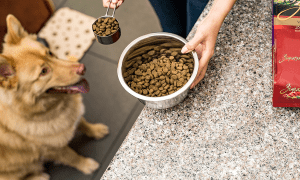“This post contains affiliate links, and I will be compensated if you make a purchase after clicking on my links.”
When we first brought our beagle, Blue, home, he fit in the palms of my hands. We’ve since enjoyed 13 wonderful years together, and he’s given us endless joy, mischief, and love. Becoming a pet parent continues to be one of the most rewarding things I’ve done, but it’s also taken a lot of work and money.
While it was easy to say yes to Blue’s furry face and puppy dog eyes, that endless mischief I mentioned has come with some costly vet bills. There have also been plenty of other unexpected costs we didn’t anticipate.
If you’re thinking about welcoming a dog to your family, here are some realistic budget items you may want to think about beforehand.

9 hidden (and not-so-hidden) costs of dog ownership
1. Essential items
Essential items for your dog can’t be too expensive, can they? According to the AKC, dog food alone can cost anywhere from $120 to $900 annually, depending on the brand you buy. Add to that regular heartworm and flea and tick treatments, which average about $50 each for a three-month supply, and you’re looking at an additional $400 in annual costs. That’s not including essential costs like a collar and leash or routine purchases like poop bags.
2. Vet bills, especially in the first year
When Blue was a puppy, he had worms, an intestinal blockage (after eating a hole in his blanket), and he broke a toe and needed a cast. Between these expenses, microchipping, and routine vet care, we ended up spending about $2,500 in his first year alone. Now, we pay around $350-400 each year (in Massachusetts) for a routine senior dog check-up.
3. Dog walker and boarding when you go away
Dog walking and boarding are additional costs that we didn’t consider when we welcomed Blue into our family. While these expenses have been relatively low for us because I work remotely and we don’t vacation often, they can get expensive if you work outside your home or take trips frequently. According to HomeGuide, the average cost of a dog walker is about $20 per walk, while dog boarding is around $40 per night.
4. Grooming
We bring Blue to the groomer four times a year, and we typically pay about $40 each time. Since he has short fur and we’re OK with brushing his coat and teeth and bathing him at home, his grooming costs are pretty low. That said, grooming costs vary based on the type of dog you have, where you live, and whether you’re comfortable brushing your dog’s teeth and putting him/her in your bathtub.
5. Pet insurance
Remember when I said we spent about $2,500 on vet care in Blue’s first year alone? Thankfully, we had pet insurance at the time, which helped us recoup a decent portion of that cost. For us, paying $30 a month for pet insurance was totally worth it when he was young. However, we opted to cancel our coverage when he was around eight years old because the monthly premiums had doubled in cost. He has no significant health concerns, so it reached a point where the cost outweighed the benefit.

6. Dog license and dog park membership
Depending on where you live, you may need to pay for a dog license and a dog park membership. We pay $15 each year for Blue’s dog license, which is required in our town, but we can go to the dog park for free. Requirements and costs vary, so check your local government website for more info.
7. Pet deposits or fees
If you rent a home with your dog, your landlord or management association may charge a one-time pet deposit or a monthly fee to have a dog. These costs can vary widely depending on who you’re renting from and where you live. Contact your landlord or association to ask about pet deposits or fees.
8. Putting in a fence
If you’re a homeowner, fencing in your yard can give you peace of mind that your dog will stay safe and close by outside. Even the best, most well-behaved dogs like to explore from time to time. But installing a fence is expensive. According to HomeAdvisor, the average cost to install a fence is $2,700. However, it can range from $1,000 to $10,000, depending on where you live and the size of your yard.
9. Miscellaneous
Each year, we give Blue a stocking full of soft toys and chew toys for Christmas. While we typically spend around $40 on toys and treats each December, dental chews are a regular expense for our family year-round. On average, we pay about $10 a month for a 24-pack of dental chews.
How to prepare for pet care costs
When you factor in all these costs, dog ownership may be much more expensive than you initially thought. But don’t get discouraged — there are ways to prepare and ensure you have the money you need for pet care.
1. Have a budget for your pup
If you’re planning to welcome a dog to your family, adjust your budget first. Estimate your monthly costs based on the type of dog you plan to get and account for them in your existing budget. Doing so will offer some visibility into what you’ll be spending on your furry family member each month. Use the list above as a starting place, then modify your budget once you have a good sense of your actual costs.

2. Dedicated emergency fund
According to PetPlan, the average cost of emergency vet care ranges from $800-$1,500 per visit. That said, we’ve all heard stories of friends and family members paying much higher emergency vet bills. In addition to factoring routine costs into your budget, it’s also important to create an emergency fund for your pup. Consider opening a dedicated savings account and setting up automatic monthly deposits. That way, you’ll have some money set aside if your furry family member breaks a toe or ends up with an intestinal blockage, like Blue.
3. The right credit card
When used responsibly, the right credit card can also help make pet care costs more manageable. Some credit cards, like the Citi Double Cash, allow you to earn bonus cash back on your everyday purchases. If you use your card for routine expenses, you can earn hundreds of dollars in cash back each year.
The bottom line
If you’re planning to welcome a dog into your family, congratulations — having a furry family member is a rewarding and wonderful experience. And while it can be expensive, it’s totally worth the cost. Trust me; I wouldn’t trade our 13 years with Blue for anything. By creating a plan, saving, and using the right tools, you’ll ensure that you have the money you need to cover the hidden (and not-so-hidden) costs of pet ownership.
Jess Ullrich is an editor at FinanceBuzz, a personal finance site on a mission to democratize financial independence. FinanceBuzz empowers its readers by teaching them how to make smart moves with their money, from utilizing credit cards to boosting income with side hustles and more.


















Max
says:Actually, I do have a piggy bank for my dogs. I put $5 to $10 a week in & it really helps with those expensive flea & heartworm meds.
Great idea! I love this!